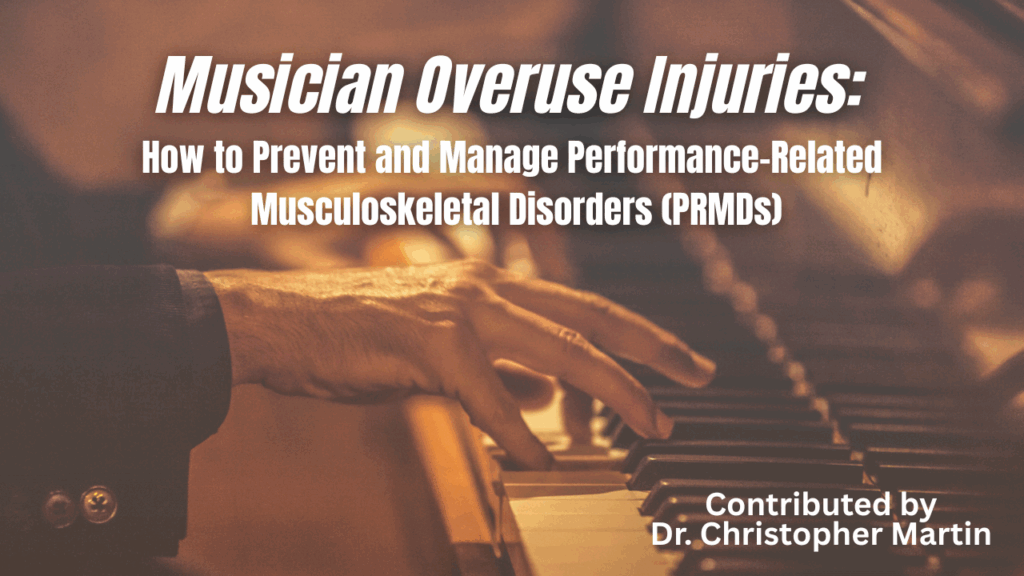New York City is a global hub for music, attracting aspiring musicians from around the world to study at prestigious institutions such as Juilliard, Manhattan School of Music, and NYU. With its vibrant cultural scene and endless opportunities to perform, music is deeply embedded in the fabric of daily life—whether through community ensembles, subway performances, or jam sessions. However, just like athletes, musicians are at risk of overuse injuries due to repetitive motion and physical strain.
In this blog, Dr. Christopher Martin of NY Bone & Joint Specialists discusses musician overuse injuries, also known as performance-related musculoskeletal disorders (PRMDs). These injuries are common among musicians, particularly those who spend long hours practicing without proper technique, rest, or ergonomic setup. Below, we explore the types of overuse injuries musicians face, how to recognize symptoms, and strategies for prevention and treatment.
Common Musicians’ Overuse Injuries
1. Carpal Tunnel Syndrome (Median Nerve Compression at the Wrist)
- Common Instruments: Piano, guitar, drums, woodwinds (flute, clarinet, oboe)
- Symptoms: Numbness, tingling, pain in the thumb, index, and middle fingers, hand weakness, nocturnal symptoms
- Treatment: Wrist splinting (especially at night), activity modification, NSAIDs, corticosteroid injections, PRP injections, and surgery for severe cases
- Prevention: Ergonomic hand/wrist positioning, regular breaks, stretching, avoiding excessive force or repetitive wrist flexion
Carpal Tunnel Syndrome is one of the most common overuse injuries among musicians. Prolonged repetitive motions, like those seen in piano playing or woodwind performance, can lead to median nerve compression, resulting in pain, tingling, and numbness in the hand.
2. Lateral Epicondylitis (Tennis Elbow)
- Common Instruments: Violin, viola, guitar, piano, drums
- Symptoms: Pain and tenderness over the outer elbow, worsened by gripping or lifting, possible forearm radiation
- Treatment: Rest, forearm bracing, NSAIDs, physical therapy, PRP injections, prolotherapy injections, corticosteroid injections, rarely surgery
- Prevention: Proper technique, forearm strengthening, gradual increase in playing time, stretching
Tennis Elbow, or lateral epicondylitis, is a condition that results from excessive gripping and wrist extension, common in string instrument players and drummers. Strengthening exercises for the forearms and proper technique can reduce the risk of this painful condition.
3. Rotator Cuff Tendinopathy (Shoulder Overuse Injury)
- Common Instruments: Violin, viola, cello, double bass, guitar, flute
- Symptoms: Shoulder pain (especially overhead), weakness, limited range of motion
- Treatment: Activity modification, NSAIDs, physical therapy, PRP injections, corticosteroid injections if needed
- Prevention: Posture correction, shoulder/upper back strengthening, avoiding prolonged overhead playing
Musicians who frequently raise their arms, such as violinists and guitarists, are at risk of developing rotator cuff tendinopathy. This shoulder injury occurs due to repetitive overhead motions, leading to pain, weakness, and restricted movement.
4. Trigger Finger (Stenosing Tenosynovitis)
- Common Instruments: Piano, guitar, violin, cello
- Symptoms: Finger stiffness, pain, catching or locking with movement
- Treatment: Activity modification, splinting, NSAIDs, corticosteroid injections, surgical release for persistent cases
- Prevention: Limiting repetitive gripping, ergonomic grips, hand stretching
Trigger finger occurs when the tendons in the fingers become irritated from repetitive gripping, common in pianists and guitarists. The condition causes pain, stiffness, and a locking sensation in the affected finger.
5. Cervical/Upper Back Myofascial Pain Syndrome
- Common Instruments: Violin, viola, cello, guitar, piano, woodwinds
- Symptoms: Neck/upper back pain, muscle tightness, trigger points, possible radiation to the shoulder/arm
- Treatment: Physical therapy, postural correction, myofascial release, heat/ice, ergonomic adjustments, trigger point injections
- Prevention: Proper posture, regular breaks, neck/upper back strengthening, instrument support aids
Musicians, particularly string players and pianists, may experience neck and upper back pain from poor posture during long hours of practice. Strengthening exercises and regular breaks can help reduce tension and discomfort in these areas.
The Importance of Prevention and Early Intervention
Preventing overuse injuries in musicians is crucial to maintaining long-term performance. Dr. Martin stresses that early intervention and targeted prevention can significantly reduce the incidence and severity of these injuries. Musicians should focus on proper technique, ergonomic setup, and regular breaks during practice to avoid the physical strain that leads to overuse injuries.
- Proper Technique: Ensuring that musicians use correct posture and technique is the foundation of preventing musculoskeletal injuries. For example, maintaining neutral wrist positioning while playing piano or guitar can reduce strain on the joints and tendons.
- Ergonomic Setup: Adjusting the setup of instruments and seating can make a big difference. Using adjustable chairs, stands, and proper hand positioning can reduce the risk of developing conditions like carpal tunnel syndrome or rotator cuff tendinopathy.
- Regular Breaks: Taking short, frequent breaks during practice allows muscles to recover and reduces the strain on joints and tendons.
When to Seek Medical Help
If a musician experiences persistent pain, weakness, tingling, or other concerning symptoms, it’s essential to seek medical attention promptly. Early diagnosis and treatment can prevent further injury and ensure that musicians can continue playing at their best.
In cases where conservative treatments like physical therapy, NSAIDs, and ergonomic adjustments do not provide relief, PRP injections, corticosteroid injections, or in rare cases, surgery, may be necessary to address the injury.
Final Thoughts
Musicians often push their bodies to the limit in pursuit of their craft, but it’s important to listen to your body and take steps to prevent overuse injuries. By incorporating proper technique, ergonomic practices, and regular breaks into practice routines, musicians can protect themselves from the aches and pains that often accompany years of playing.
At NY Bone & Joint Specialists, we specialize in treating performance-related musculoskeletal disorders (PRMDs) and helping musicians stay at the top of their game. If you’re experiencing pain or discomfort from playing, contact us today to schedule an evaluation.
About Dr. Christopher Martin
Dr. Christopher Martin is an orthopedic specialist at NY Bone & Joint Specialists, with expertise in treating musculoskeletal injuries, including performance-related disorders in musicians. He is dedicated to providing personalized care to help musicians recover and continue performing pain-free.




